SARG team to present at UK Society for Behavioural Medicine Annual Scientific Meeting

Luke Wilson, Anna Butters and Maddy Henney will present on no- and low-alcohol drinks, Dry January and food insecurity.
UKSBM 2024 takes place in Glasgow on 13th and 14th March 2024 and aims to showcase the best of the UK's research into behavioural medicine.
The Sheffield Addictions Research Group (SARG) is well represented with three spots in the programme:
Luke Wilson: Current and future trends in the consumption, sales and purchasing of no- and low-alcohol products in Great Britain between 2014 and 2023
Luke will talk about research carried out as part of an NIHR-funded project examining the potential impact of no- and low-alcohol (no/lo) drinks on public health in Britain.
The research shows that sales of no/lo drinks have been increasing and are projected to continue to grow steadily in both the on- and off-trade. It also predicts a growth in the number of people using no/lo drinks in their attempts to moderate their alcohol intake.
The presentation will look in detail at data sources and analysis methods, key figures and estimates for future sales and consumption trends.
Anna Butters: Understanding reductions in alcohol consumption following participation in Dry January
Anna will present findings from her PhD research which is investigating the long-term effects of Dry January on alcohol consumption.
Her research has found that people who participate in Dry January, especially those who register for the official campaign, are found to drink less six months later.
The research also looks at what factors might help people maintain this change – she found that believing in your ability to resist drinks (drink refusal self-efficacy), feeling less like a "drinker" in general, and being motivated to change are all linked to alterations in alcohol consumption after Dry January.
Maddy Henney: A conceptual model of food insecurity interventions
Maddy will present a poster on her work developing a conceptual model for assessing the effectiveness of different interventions that aim to reduce food insecurity.
The model considers various factors that might influence someone's decision to use a food insecurity intervention such as a food bank or social eating space, like how easy it is to get to or if people feel comfortable using it.
The model is the first step towards building a mathematical tool that can estimate the impact and effectiveness of different food insecurity interventions.
SARG researchers share insights into youth and student drinking at national conference
Researchers from the Sheffield Addictions Research Group (SARG) recently presented their findings on youth and student drinking trends at the Student Health Association Annual Conference, held from Sunday 29 June to Tuesday 1 July 2025 in Sheffield.
SARG researchers co-author new book exploring 'culture of caution' in youth drinking decline
A new book by an international team of experts, including researchers from the Sheffield Addictions Research Group (SARG), unpacks the complex social, cultural and economic factors driving the decline in young people's alcohol consumption.
SARG's Lucy Burke wins Open Research Prize 2025
Lucy Burke, a Qualitative Research Associate and PhD Student with the Sheffield Addictions Research Group (SARG), has been awarded the University of Sheffield Open Research Prize 2025 in the Postgraduate Researcher (PGR) category.
SARG showcases research at School of Medicine and Population Health event
Researchers from SARG are set to showcase their work at the University of Sheffield's School of Medicine and Population Health Research and Innovation Meeting 2025.
You might also be interested in…
SARG's Lucy Burke wins Open Research Prize 2025
Lucy Burke, a Qualitative Research Associate and PhD Student with the Sheffield Addictions Research Group (SARG), has been awarded the University of Sheffield Open Research Prize 2025 in the Postgraduate Researcher (PGR) category.
SARG showcases research at School of Medicine and Population Health event
Researchers from SARG are set to showcase their work at the University of Sheffield's School of Medicine and Population Health Research and Innovation Meeting 2025.
SARG Heads to Glasgow for 50th Anniversary KBS Symposium
A team of twenty researchers and PhD students from the Sheffield Addictions Research Group (SARG) will be participating in the landmark 50th Anniversary KBS Symposium for Social and Epidemiological Research on Alcohol next month.
